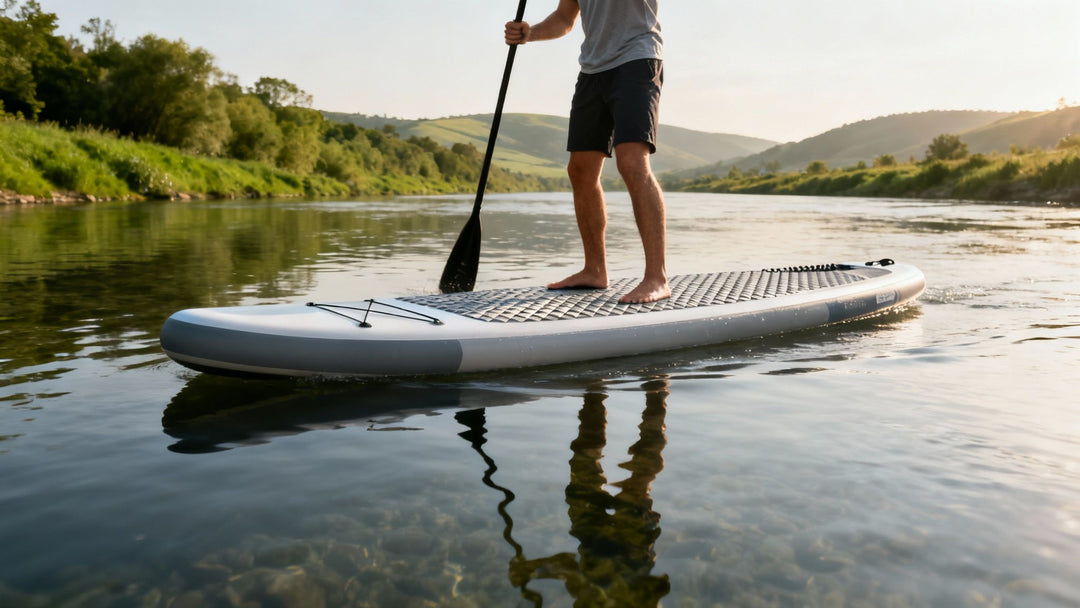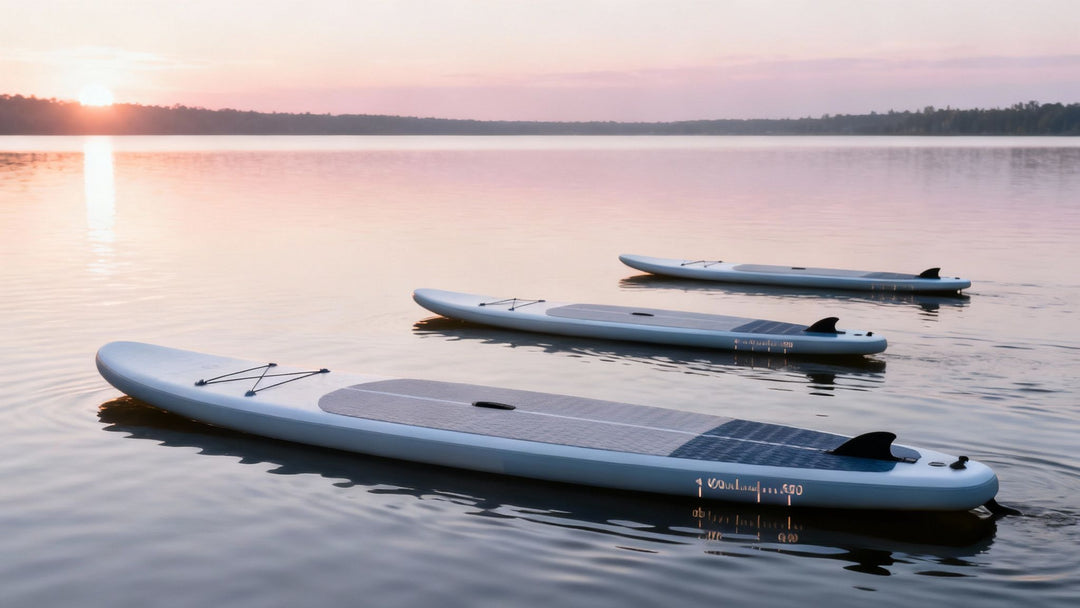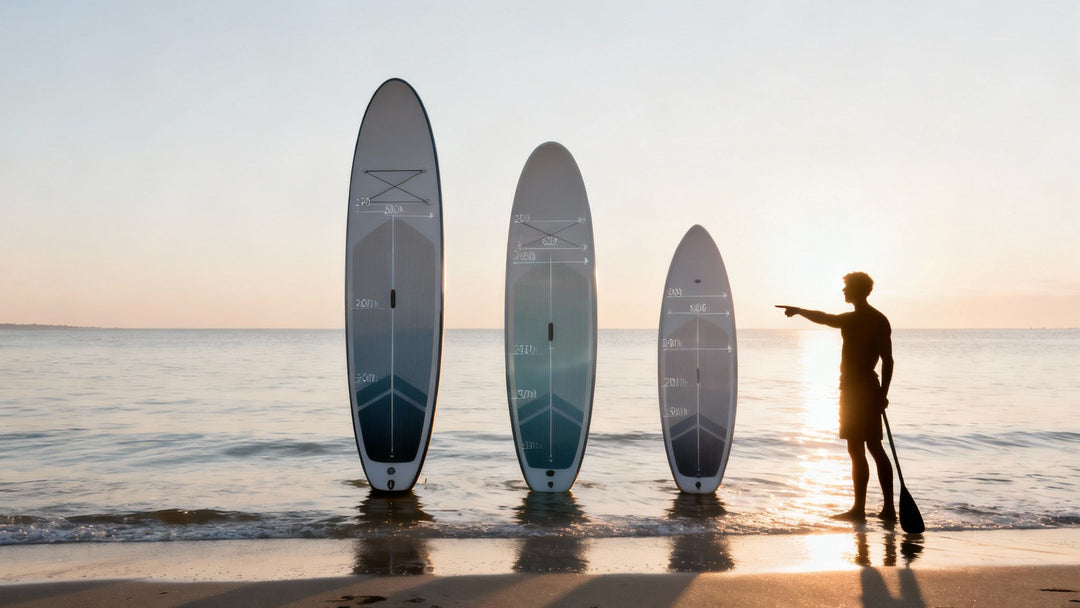Finding the Best Paddle Board for Beginners
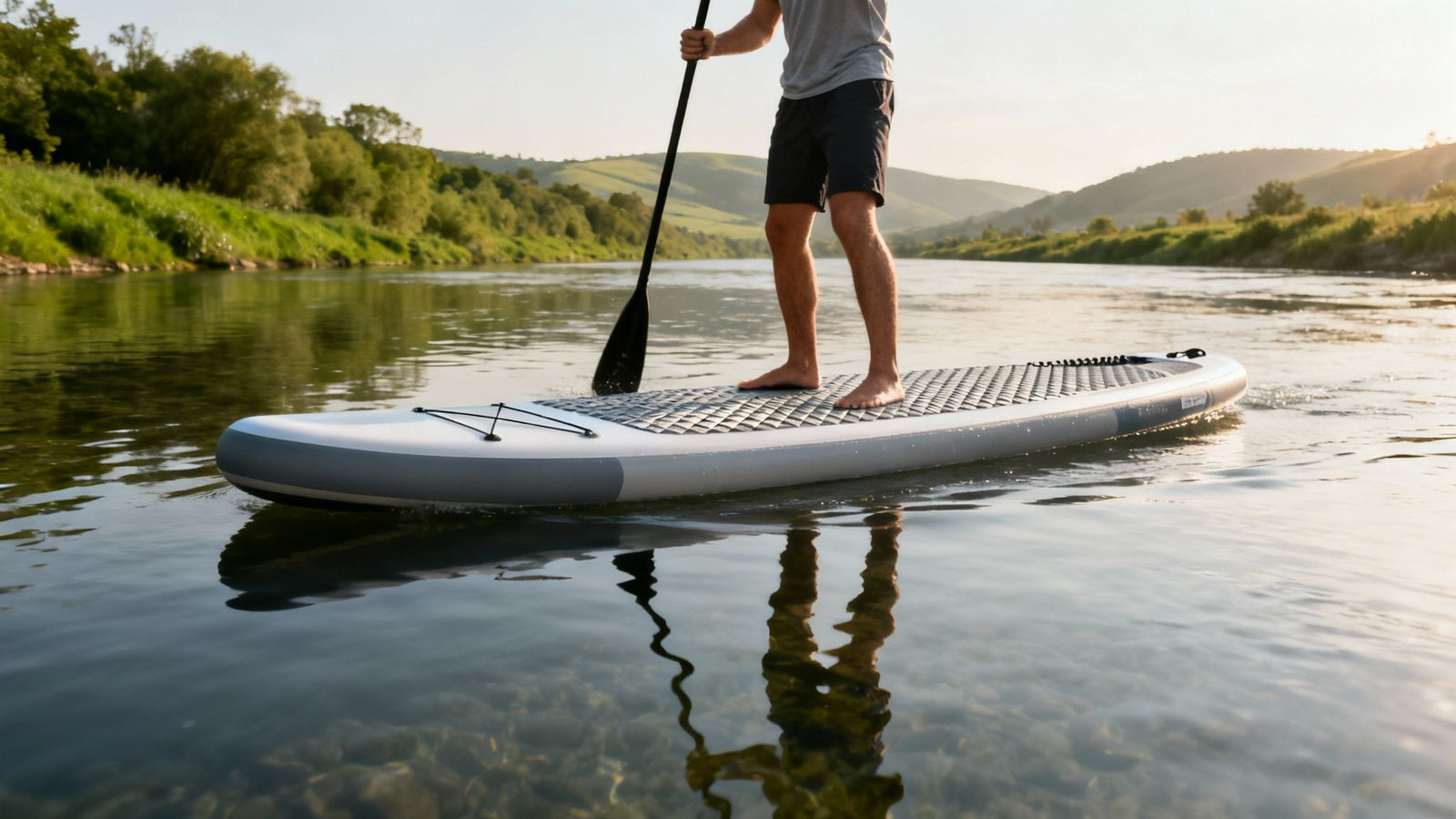
If you're just starting out, the best paddle board you can buy is a stable, all-around inflatable stand-up paddleboard (iSUP). For that rock-solid feeling under your feet, look for a board that’s at least 32 inches wide. That width, combined with plenty of volume, gives you a forgiving platform that makes learning a breeze.
Your First Paddle Board Explained
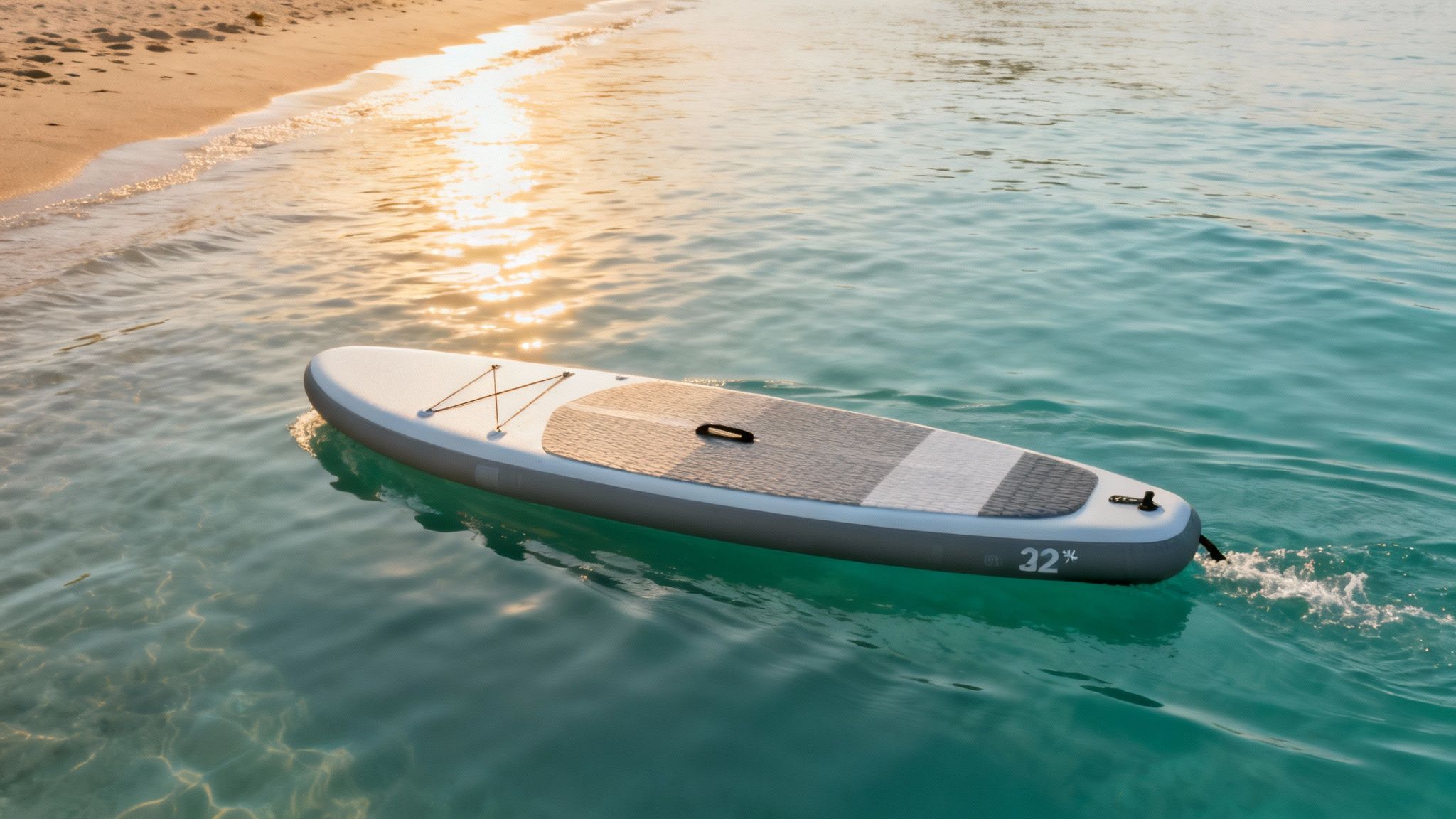
Welcome to the amazing world of stand-up paddleboarding! I know that choosing your first board can feel like a massive task with all the options out there, but trust me, it doesn't have to be complicated. The absolute key is to prioritise stability above everything else.
Think of your first board like a bike with stabilisers. Its only job is to help you build confidence, find your balance, and actually enjoy being on the water without constantly worrying about taking a dip. For example, imagine trying to learn on a narrow, tippy race board on a slightly choppy day at your local lake – it would be incredibly frustrating. A wobbly board can easily put you off the sport for good. This is exactly why a wide, high-volume all-rounder is the perfect place to start.
Why All-Around iSUPs Are Ideal
An all-around board is the jack-of-all-trades of the SUP world. It's designed to be a versatile workhorse, handling everything from flat lakes to gentle coastal chop without any fuss. For a beginner, that forgiving nature is a huge advantage.
Here in the UK, paddleboarding has absolutely exploded in popularity, especially with newcomers. It's no surprise that the inflatable paddle board market, which is loved by novices for being so portable and durable, makes up a massive 47.3% of the global share. Recreational and all-around boards are leading that charge.
This trend is exactly why boards like our Loco Amigo Air iSUP are so popular. We designed it specifically for new paddlers, combining generous width, thickness, and a user-friendly shape into one confidence-boosting package. A practical example is a family wanting a board they can all use at the weekend; the Amigo Air's stability means both a lighter teenager and a heavier adult can feel secure while learning. It’s the perfect launchpad for your new hobby.
A stable board is the foundation of a good first experience. It allows you to focus on mastering your paddling technique and enjoying the scenery, rather than constantly struggling to stay upright.
As you get into your paddleboarding journey, part of the fun is thinking about all the places you'll go. You might even find yourself dreaming of adventures like Stand Up Paddling in Amsterdam once you've found your feet. Getting started with the right gear ensures your first time on the water is a massive success, setting you up for countless adventures to come.
Inflatable vs Hard Boards for Beginners
Sooner or later, every new paddler hits the same crossroads: should I go for an inflatable board or a traditional hard board? While both have their merits, for most people just starting out in the UK, an inflatable stand-up paddleboard (iSUP) is the hands-down winner. The reason? It all comes down to simple, real-world practicality.
Just think about it. Try cramming a rigid 10-foot board into a city flat, or hauling it to the coast without a roof rack. It's a logistical nightmare. Now, picture an iSUP like the Loco Amigo Air. It packs down into a backpack you can toss in the car boot of a small hatchback or stash in a cupboard under the stairs. When it comes to convenience and storage, inflatables are in a league of their own.
Durability and Everyday Use
A massive worry for anyone new to paddleboarding is damaging their shiny new board. Let's be honest, when you're learning the ropes, you're going to have a few bumps and scrapes. You might nudge some rocks on a riverbank, graze a wooden jetty, or even drop your board on a gravel car park. This is exactly where modern iSUPs prove their worth.
High-quality inflatables are incredibly tough. They’re built to bounce off the very same obstacles that would leave a nasty chip or crack in a fibreglass or epoxy hard board. That built-in ruggedness gives you priceless peace of mind, letting you focus on finding your sea legs and enjoying the paddle, not stressing about a costly repair bill. The premium construction of a Loco iSUP means it can handle these minor impacts without any issue.
Performance and Feel on the Water
Right, this is where the debate gets a bit more interesting. A hard board will always have a slight edge when it comes to pure performance. It cuts through the water more cleanly, giving you better glide and a more connected, responsive feel. That’s why you’ll see racers and serious SUP surfers sticking with them. If you’re curious about their specific advantages, dive into our detailed guide on why to choose a hard board over an inflatable.
But for a beginner's needs? The performance you get from a premium iSUP is more than enough. They’re comfortable underfoot, massively stable, and versatile enough for you to explore the UK’s incredible coastlines, lakes, and rivers. That tiny trade-off in top-end speed is a small price to pay for the huge wins in portability, durability, and sheer ease of use. This shift towards user-friendly gear is a big reason the market is set to boom from USD 1.2 billion to over USD 3 billion by 2035. It's all driven by innovations that make boards tougher and more stable for newcomers. You can discover more about these SUP market trends here.
For your first board, the single most important thing is getting out on the water as often as possible. An inflatable SUP simply removes the biggest hurdles—storage and transport—making it the most practical and encouraging choice to kickstart your paddleboarding journey.
Choosing the Right Board Dimensions
Getting your board's size right is the secret to a great day on the water. Don't just think of board dimensions as a set of numbers; they're the core formula for your stability, speed, and overall fun. For anyone just finding their sea legs, getting these three elements—width, length, and volume—spot on is the most important step in choosing a board.
Width is Your Best Friend
When you're starting out, width is your best friend. A wider board creates a bigger, more stable platform, which makes balancing a whole lot easier. Think of it like standing on a wide pavement versus a narrow kerb; that extra surface area gives you confidence and forgives the odd wobble while you're learning.
This is exactly why most beginner-friendly boards, including our own Loco Amigo Air, measure between 32 and 34 inches wide. This sweet spot provides a solid, steady base that helps keep you dry and smiling.
Length Speed and Turning
While width is all about stability, a board's length dictates how it moves through the water. For an all-rounder, you'll typically be looking at lengths from 10'6" to 11'6". A longer board tends to track straighter and glide faster, which is brilliant for covering distance on a calm river or lake.
On the flip side, a shorter board is much easier to turn and manoeuvre. The 10'6" length of the Loco Amigo Air really hits that perfect middle ground. For example, it's long enough to cruise efficiently along a canal, but short enough to easily navigate around moored boats or tight bends. It has enough glide for exploring but stays nimble enough for you to handle with ease, making it a fantastic, versatile choice for UK waters.
The infographic below really nails the practical choice between an inflatable board (which often has these beginner-friendly dimensions) and a hard board, which is usually geared more towards performance.
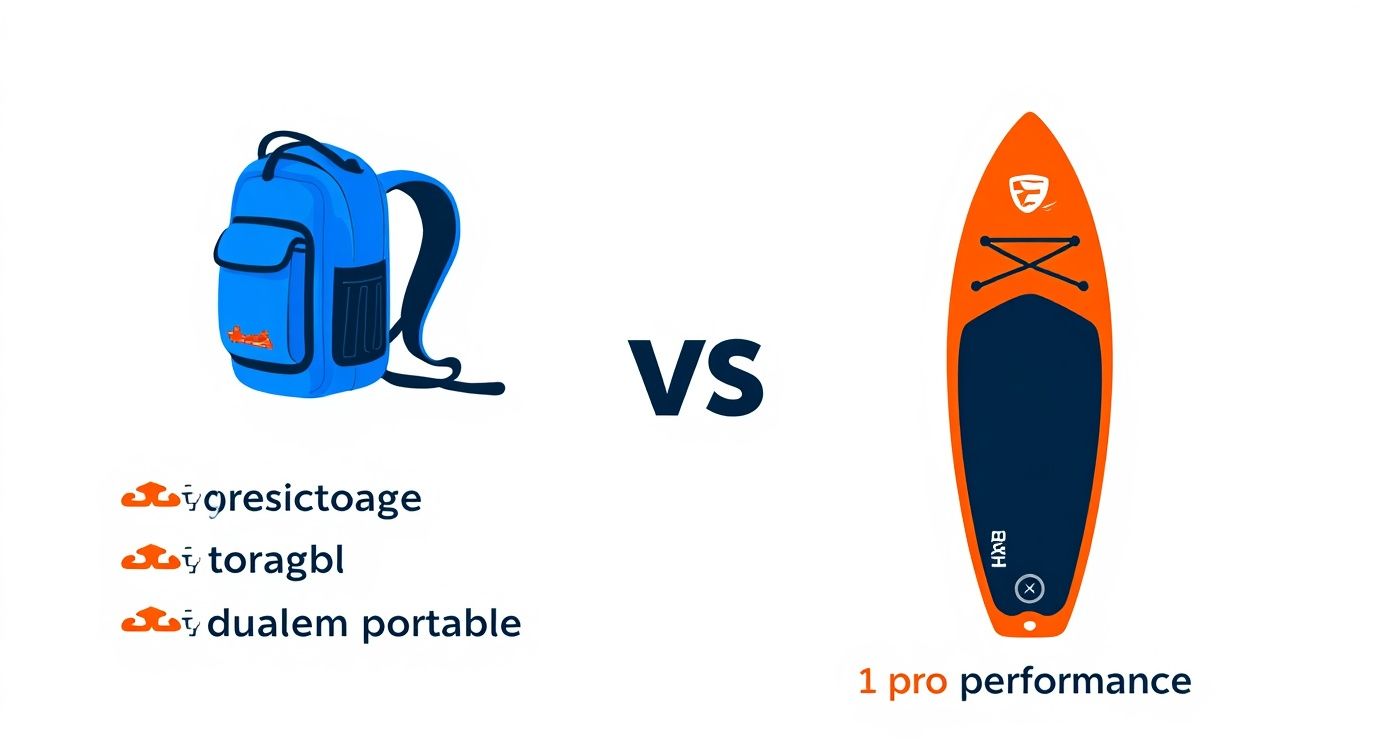
As you can see, the sheer convenience of an inflatable is a huge draw for beginners, and it aligns perfectly with the forgiving dimensions that make learning a breeze.
Volume Flotation Power
Finally, let's talk about volume. Put simply, this is your board’s ability to float, measured in litres. It's directly linked to how much weight the board can support while staying high on the water. If the volume is too low for your weight, you'll find the board feels unstable and sits too low in the water.
Matching your body weight to the correct board volume is crucial. It ensures you ride on top of the water, not partially submerged in it, which is key for stability and efficient paddling.
Getting this right is a simple bit of maths, but it makes a world of difference to your experience. We've put together this quick guide to give you a solid starting point.
Beginner SUP Sizing Guide
This table will help you match your weight to the ideal board dimensions for general, all-around paddling.
| Rider Weight (kg) | Recommended Board Width | Recommended Board Length | Ideal Volume (Litres) |
|---|---|---|---|
| 50-70 kg | 30" - 32" | 9'6" - 10'6" | 170 - 220 L |
| 70-90 kg | 32" - 34" | 10'6" - 11'6" | 220 - 270 L |
| 90-110 kg | 33" - 35" | 10'8" - 12'0" | 270 - 320 L |
| 110+ kg | 34" - 36" | 11'0" - 12'6" | 320+ L |
Remember, this is a general guide. For a more precise recommendation tailored to you, our guide on what size paddle board you need has an in-depth chart and explanation. A board like the Loco Amigo Air is designed with plenty of volume to comfortably support a wide range of new paddlers, giving you a buoyant and secure feel from your very first stroke.
What Makes a Good Board? Construction and Features
When you're looking for your first paddle board, it’s what’s on the inside that really counts. Sure, a cheap board might look the part, but it’s the hidden engineering that makes a quality board feel solid and responsive under your feet. Let's get into why paying a little more for quality construction pays you back every time you're on the water.
This is all about performance, durability, and ultimately, how much fun you have.
The Magic of Drop-Stitch Technology
Ever wondered how an inflatable board can feel so surprisingly stiff? The secret is something called drop-stitch construction.
Don't just picture a balloon filled with air. Instead, imagine the inside of the board is a complex honeycomb structure, woven together by thousands of tiny, super-strong threads. These threads connect the top and bottom surfaces. When you pump it up, they pull tight, creating an incredibly rigid and stable platform.
Higher-end boards, like the ones we make at Loco, pack more of these threads into every square inch and use advanced fusion layering. This makes the board lighter but much stronger, so it won’t bend or flex in the middle. A practical example of this is when you stand on a cheap board, you might see the nose and tail flex upwards like a banana; a premium Loco board stays flat and rigid, feeling much more like a traditional hard board when you're paddling.
Essential Features for Control and Comfort
Beyond the core, a few key features make a world of difference to your paddling experience. First up is the deck pad. A comfortable, grippy surface is non-negotiable for keeping your balance and preventing your feet from getting tired, especially on longer paddles. Look for a diamond-groove pattern, as this texture gives you fantastic traction while channelling water away.
Another deal-breaker is the fin setup. Think of fins like the rudder on a boat – they stop the tail of your board from swinging side-to-side with every stroke. This is called tracking, and it's what helps your board glide in a straight line, making your paddling so much more efficient. Most beginner boards come with a large, removable centre fin, which gives you the best stability and straight-line performance.
The image below from Go Paddling shows a group out enjoying the sport, a perfect example of how the right kit makes for a great day.
This really brings home the importance of being well-prepared, which is where reliable equipment is everything. For official advice on staying safe out there, we always point people to the British Canoeing website. Investing in a well-made board means you can trust it to perform safely and predictably, every single time.
Essential Gear for Your First Paddle
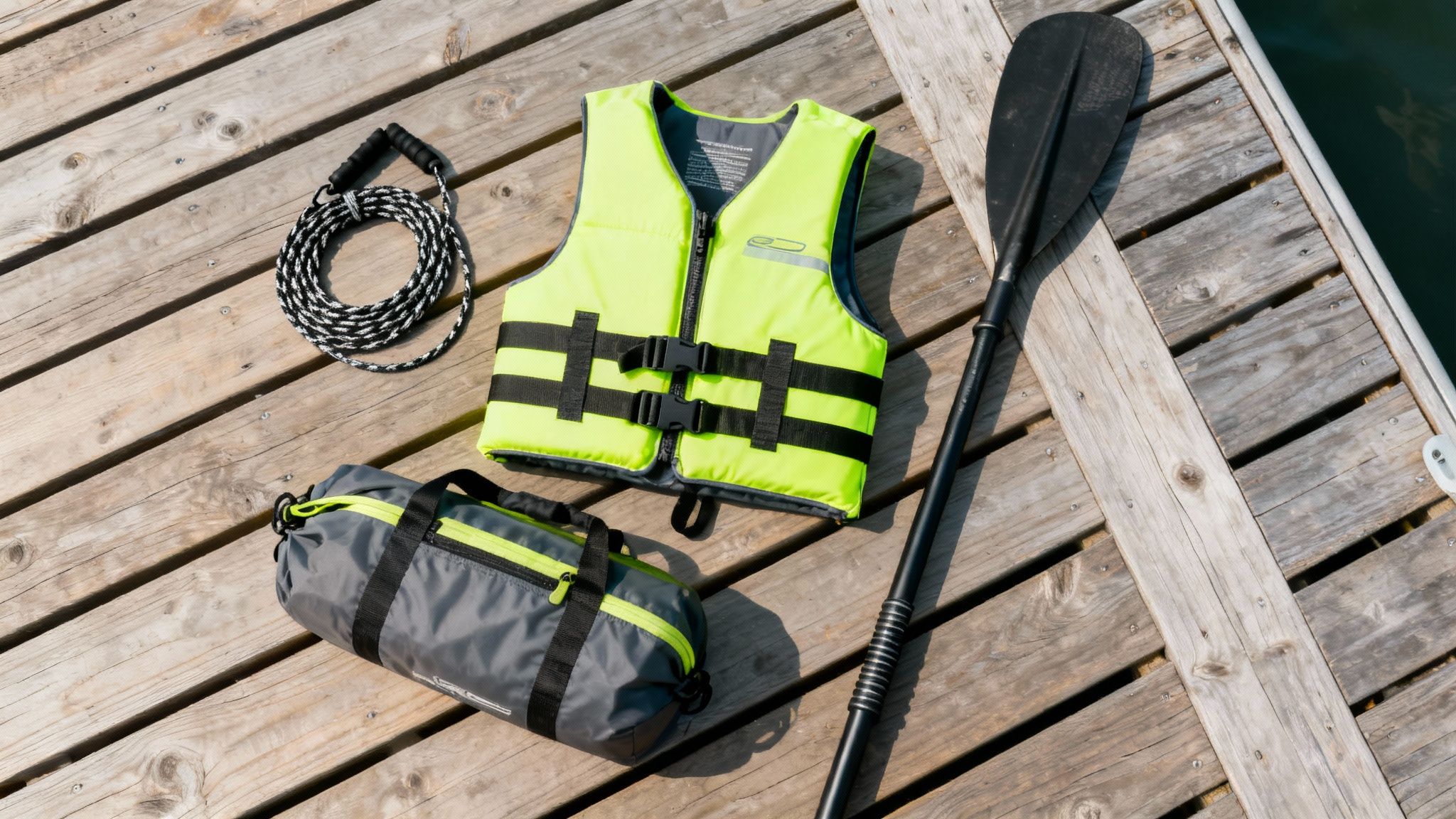
While your board is the star of the show, having the right accessories is what turns a good day on the water into a great one. Getting your kit sorted out from the start means every paddle is safe, comfortable, and totally hassle-free.
Think of this gear as your essential support crew. These items aren’t just optional extras; they're fundamental to having a brilliant time when you're just starting out.
Your Safety Non-Negotiables
First, let's talk about the two things you should never, ever launch without: a leash and a personal flotation device (PFD). Your leash is literally your lifeline, keeping you tethered to your board if you take a tumble. That's a huge safety net, especially if the wind picks up or you're in a current.
Next up is a PFD, often called a buoyancy aid. This is crucial for staying afloat and saving energy if you find yourself in the water longer than expected. For a deeper dive, check out our guide on choosing a buoyancy aid for SUP. For a more comprehensive look at staying safe on the water, you can also explore resources on essential boating safety equipment.
Your board is your biggest float, but a leash and PFD are your personal safety system. Never treat them as an afterthought.
Smart Gear Choices
Your paddle is your engine, and upgrading from the heavy, basic aluminium one that often comes with cheaper packages can make a massive difference. Lighter fibreglass or carbon paddles seriously reduce fatigue in your arms and shoulders, letting you paddle for longer and with much better technique.
Other practical bits of gear include:
- A Quality Carry Bag: This makes getting to the water and storing your board a breeze, all while protecting it from dings and scrapes.
- A Dry Bag: An absolute must-have. It keeps your phone, keys, and snacks bone dry, no matter what.
- Appropriate Clothing: Always dress for the water temperature, not the air temperature. This is key, especially with our notoriously unpredictable UK weather!
Complete packages like the Loco Amigo Air are perfect because they bundle all this essential gear together. It’s a well-thought-out kit that gives you everything you need to start your adventures right out of the box, including a high-quality paddle and durable bag, not just the basic accessories.
Common Beginner Mistakes to Avoid When Buying
Getting your first board purchase right saves you a world of frustration, not to mention time and money. Knowing what not to do is just as important as knowing what you're looking for, especially when you're just dipping your paddle in the water.
The biggest rookie mistake? It often comes down to where you buy from. A huge, generic retail store might seem like the easy option, but you'll be hard-pressed to find staff with any real paddling experience. They sell everything under the sun and simply can't offer the specialist advice you need to make a good choice.
Contrast that with a dedicated retailer like Loco Surfing, where we live and breathe this sport. You'll get honest, first-hand advice from people who are out on the water using the gear they sell. That means you get a board that’s a perfect match for you, not just whatever's on promotion that week.
Sidestepping Common Pitfalls
Beyond where you shop, a few classic slip-ups can catch out new buyers. Just being aware of them is the first step towards buying a board you'll be chuffed with for seasons to come.
A very common one is buying a board that’s too narrow for your weight. Sure, it might look sleek, but a skinny board is a wobbly board, and you'll spend more time in the water than on it. This is exactly why checking a board's width and volume against your weight is so crucial.
A cheap package deal often seems like a bargain, but it’s usually a false economy. The paddle they throw in is often heavy and clunky, the pump can be flimsy, and the whole experience of getting set up becomes a chore before you’ve even hit the water.
Another classic error is accidentally picking a board designed for a niche discipline. That super-pointy racing SUP or the short, curvy surf SUP might look the business, but they're built for very specific things and are notoriously unstable for general paddling. Your best bet is always to start with a proven all-rounder like a Loco Amigo to build your skills.
Our goal is to help you find a board you’ll love for years, not one you'll outgrow or want to replace after one season. You can check out a range of trusted, high-quality beginner setups in Loco's online shop, knowing you're getting gear that's actually designed to help you succeed.
Frequently Asked Questions
Jumping into the world of paddleboarding always brings up a few questions. To get you out on the water feeling confident, we’ve put together answers to some of the most common things new paddlers ask.
Getting these basics sorted means you can focus on what really matters—having a great time out there.
How Hard Is It to Learn Stand Up Paddleboarding?
Honestly, it’s much easier than you’d think! The secret is starting with the right gear in the right conditions. Give most people a wide, stable board on calm water, and they’re usually up and paddling comfortably within the first hour.
A great little trick is to start on your knees first. This helps you get a feel for the board and find your balance before you even try to stand up. If you really want to fast-track your progress, a lesson from a certified instructor is a brilliant way to learn the proper paddle stroke and build your confidence from day one.
What Should I Wear for Paddleboarding in the UK?
For paddling around the UK, the golden rule is to dress for the water temperature, not the air temperature. Even on a gorgeous sunny day, the water can be surprisingly cold, so you need to be ready in case you take an unexpected dip.
Here’s a quick guide on what to wear:
- Warm Summer Days: For short paddles close to shore, quick-drying sportswear like board shorts and a rash vest will usually do the trick.
- Cooler Conditions: A wetsuit is your best friend for spring, autumn, or any longer summer trips. It’s designed to keep you warm whether you’re on the board or in the water.
- Footwear: Neoprene boots or shoes are fantastic for keeping your feet warm. They also protect your soles from sharp rocks when you're getting in and out of the water.
And, of course, always have a quick look at the weather forecast and sea conditions before you head out.
Do I Need a Licence to Paddle Board in the UK?
You’re all clear for the sea, estuaries, and most harbours – no licence needed there. However, for a lot of the UK’s incredible inland waterways, like the rivers and canals managed by bodies such as the Canal & River Trust, you will need one.
The easiest way to get yourself covered for thousands of miles of inland waterways is to become a member of Paddle UK (which you might remember as British Canoeing). Their 'On the Water' membership includes the waterway licence you'll need, so you're good to go.
Can I Take My Dog Paddleboarding?
Absolutely! Paddling with your four-legged friend is brilliant fun. The most important thing is to have a board that’s stable and spacious enough for both of you to be comfortable. A large, non-slip deck pad is a must-have to give your dog plenty of room to move around and a secure grip.
It’s a good idea to get your dog used to the board on dry land before you even think about hitting the water. And a doggy PFD (personal flotation device) is completely non-negotiable for their safety. The generous size and super-stable platform of the Loco Amigo Air make it a top choice for paddling with a furry co-pilot.
At Loco Surfing, we're here to help you kick off your SUP journey the right way with genuine, expert advice and top-quality gear. Have a look at our full range of beginner-friendly paddle boards and accessories to find the perfect setup for your adventures. https://www.locosurfing.com


